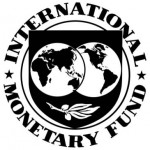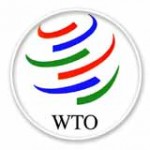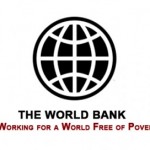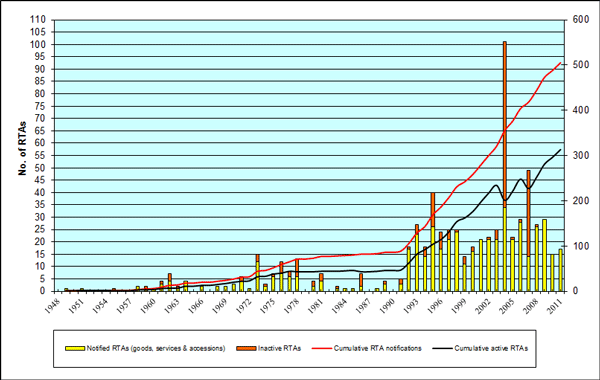Lesson Objectives:
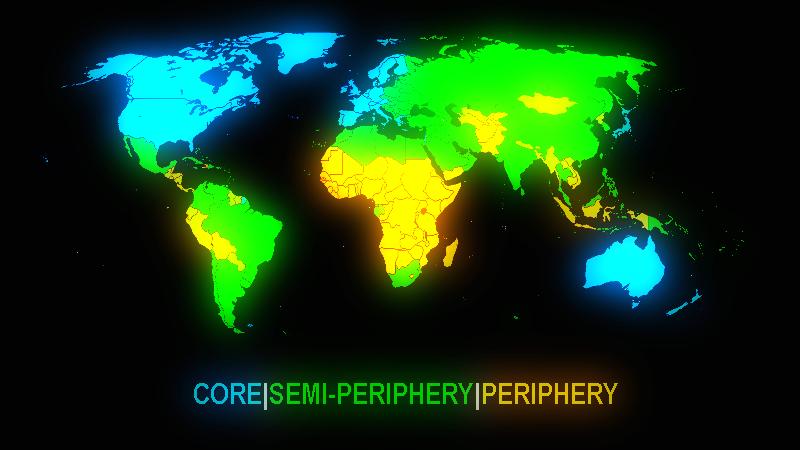
- identify and describe the modern world system
- recognize the relationship between international economies and institutions with local systems
- evaluate how local experiences are shaped by international processes
- formulate a position and solution to socio-economic problems presented in case study examples
The end of World War II marked the decline of European colonial domination. The charter for the United Nations in the second half of the 20th century aimed to integrate newly independent countries into a world-wide community of nations. Immanuel Wallerstein describes this community of nations as the Modern World System, a social system comprised of nations that are politically and economically interdependent (Wallerstein 1974). Within the modern world system, nations are hierarchically structured according to a world-wide division of labor in the world economy.
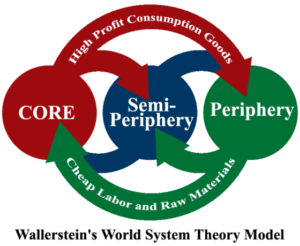 Core nations determine the terms and conditions of trade. Peripheral nations provide raw materials to core nations, who in turn, manufacture the materials into value-added products that are sold back to the peripheral nations. Semi-peripheral nations engage in a mixed system of raw materials extraction and manufacturing. Wallerstein argues that while nations shift in position within the modern world system (ie the rise and anticipated decline of the U.S. as the leading world power), the socio-economic arrangement of nations in the modern world system is primarily tied to previous colonial relationships when imperial powers extracted resources from occupied territories. He points out that many of the former colonial European powers and settler countries are positioned as core nations, while former colonies are positioned as peripheral nations.
Core nations determine the terms and conditions of trade. Peripheral nations provide raw materials to core nations, who in turn, manufacture the materials into value-added products that are sold back to the peripheral nations. Semi-peripheral nations engage in a mixed system of raw materials extraction and manufacturing. Wallerstein argues that while nations shift in position within the modern world system (ie the rise and anticipated decline of the U.S. as the leading world power), the socio-economic arrangement of nations in the modern world system is primarily tied to previous colonial relationships when imperial powers extracted resources from occupied territories. He points out that many of the former colonial European powers and settler countries are positioned as core nations, while former colonies are positioned as peripheral nations.
As Andre Gunder-Frank (1972:3) has pointed out, ‘There is an identifiable social system, based on wealth and power differentials, that extends beyond the nation-unit.’ What this means is that similar to the way that social hierarchies exist within the population of a country, there is also a hierarchical relationship among countries. Analysts have shown that the hierarchical relationships between nations is reflected by the terms of international trade which are established by the more powerful core nations and are oftentimes disadvantageous for less powerful peripheral nations (Singer-Prebisch 1950; 1998). Because of this, many political economists argue that economic integration into the modern world system leads to economic dependency on core nations as peripheral nations come to rely on trade with core nations in order to increase wealth through foreign exchange earnings. Unequal trade relations weaken the economies of the peripheral nations which further increases dependency on trade with core nations. This process is known as dependency theory.
The ideas set forth by dependency theory and the modern world system models offer important contributions to understanding culture because the peoples and cultures living in peripheral (post-colonial) areas are oftentimes blamed for the conditions of poverty created by unfair economic policies. In his book, Globalization and its Discontents (2002), former chief economist of the World Bank, Joseph Stiglitz, blamed the unfair policies of the International Monetary Fund (IMF) and the lending practices of the World Bank for destablizing the economies in peripheral nations and exacerbating poverty among their citizens. According to Stiglitz, IMF policies and practices routinely fail to consider that peripheral nations are entering into a competitive global economic arena at an uneven playing field. Fledgling nations often lack the information resources, infrastructural resources and workable institutions that they need in order to contend with the more powerful core players in the world market. As a result, peripheral nations fall into a cycle of debt accumulation that further cripples the national economy.
International Institutions
The political and economic relations between nations in the Modern World System is regulated by international institutions created during the second half of the twentieth century. The most notable institutions include the United Nations (UN), The World Bank Group, The International Monetary Fund (IMF), and the World Trade Organization (WTO). The charter for these institutions is based on a ‘peace through trade’ mission established by the Bretton-Woods Agreement in 1944.
National governments become a member of these institutions by signing charters and agreements, and the institutions provide boundaries, structures and rules of legitimation for international relations. The underlying idea set forth in the charters of international institutions is the assumption that nations that are politically and economically inter-dependent will not engage in war with one another, and that integration in the world economy will strengthen the national economy in poor countries. Political-economists have pointed out that contemporary policies and practices have deviated from the original mission set forth by these organizations, a process known as organizational slippage (Babb 2005).
Visit the websites of the following international institutions by clicking on their logo and review their mission statement.
- http://www.imf.org/external/index.htm
- http://www.wto.org/
- http://www.un.org/en/
- http://www.worldbank.org/
Modernization and Development
The policies and programs implemented by international institutions are based on the assumption that economic integration in the world economy is the solution to poverty and inequality. This approach is rooted in modernization theory and development perspectives that assume that social and economic restructuring will increase production and thereby increase national income and eliminate poverty (Kottak 2012). This idea is attributed, in large part, to the work of early functionalist sociologists and anthropologists, such as Emile Durkheim and E.B. Tylor. As mentioned in the Socio-Historical Contexts section, functionalist anthropological perspectives aim to identify the interconnected roles of social institutions in maintaining ‘order’, and and scholars usually organized social orders on a linear pathway from ‘primitive’ to ‘advanced’. Today, international institutions and governments implement Modernization and Development programs to transition so-called ‘primitive’ social institutions toward so-called ‘advanced’ models, and the outcome of that transition is expected to bring social benefits to people living in poverty.
John Bodley (2007) argues that the basic belief underlying modernization and development is rooted in the same euro-centric ideologies that aimed to justify colonial occupation for several centuries and now serve to justify the domination of the national economies of poorer countries. The notion of ‘development’ is based on evolutionary models that position distinct economies on a single pathway toward ‘advancement’ rather than considering each economy as a unique adaptive strategy to different social and environmental circumstances aimed to meet the direct needs of people in a society. He argues that industrial economies are considered more ‘advanced’ because it is the economic mode of production in core nations. In many cases, policy-makers in peripheral nations have internalized the hegemonic perspectives of the core nations and implemented modernization and development programs and policies directed at transitioning the national economy and society toward European economic models. These programs and policies, known as structural adjustment programs, are designed by international institutions and they are deeply embedded in international economic restructuring that has come to define the global world economy.
Global Economic Restructuring
Although the Bretton-Woods agreement aimed to restructure the global economy into a unified system after the second World War, the United States and the Soviet Union became engaged in a struggle over the economic organization of the new globalized economy; this struggle is known as the Cold War. During this time, the United States was building allies against the communist bloc, and capitalist ideologies based on liberty, democracy, and private property were pitted against state-centered communist ideologies based on authoritarianism, the redistribution of wealth, and state-owned property. As the documentary, States of Independence, pointed out, many newly independent post-colonial nations were caught in the political and ideological tug-of-war that characterized the Cold War as both the U.S. and the Soviet Union funded and aided political coups in order gain allies among the newly independent nations. This caused a considerable amount of political instability in young nations that were still recovering from the economic impact of long-term colonial occupation.
Neoliberalism
At the height of the Cold War, during the Reagan and Thatcher era, a series of neo-liberal policies aimed to strengthen the global capitalist alliance against communism (Harvey 2005). Neoliberalism draws from the early economic philosophy called Liberalism established by Adam Smith in his book, The Wealth of Nations (1776). Smith’s economic philosophy was based on ideas of liberty and equality that became popular during the European and American revolutions that overthrew the control of feudal monarchies during the 18th century. He advocated against centralized economic activity and argued that individuals competing in a free market would strengthen the economy and provide benefits for society. Smith’s notion of private property was quite different from contemporary ideas about capitalism and property. In the feudal systems that characterized Smith’s time, peasants labored on land that was owned and controlled by a monarch. According to Smith, the individual ownership of land was expected to allow workers to gain direct access to the fruits of their labor. Although Smith never referred to his economic philosophy as ‘capitalism’, his philosophy shaped the guiding principles of small-scale mercantile capitalism in the 19th century. Nearly 200 years after Smith, Friedrich von Hayek adapted Smith’s principles to the international economic struggle between the U.S. and the Soviet Union in his book, Road to Serfdom (1944).
Thatcherism & Reaganomics
 In the 1980s, Hayek’s neo-liberal philosophy established the foundation for international economic policies known as Thatcherism and Reaganomics. The neo-liberal policies set forth by Margaret Thatcher (British Prime Minister) and Ronald Reagan (U.S. President 1981-89) emphasized decreased government spending on social services, increased spending on military budgets, privatization, and deregulation – particularly Free International Trade. According to the neoliberal philosophy, the privatization of property and the deregulation of trade will strengthen the economy, which will in turn provide benefits and social services for society. From this perspective, everyone will benefit as the rich get richer, because prosperity is expected to ‘trickle down’ from the wealthy to the poor. These neoliberal assumptions were projected onto the world economy. After the fall of the Soviet Bloc in 1991, neo-liberalism restructured the economic organization of the Modern World System.
In the 1980s, Hayek’s neo-liberal philosophy established the foundation for international economic policies known as Thatcherism and Reaganomics. The neo-liberal policies set forth by Margaret Thatcher (British Prime Minister) and Ronald Reagan (U.S. President 1981-89) emphasized decreased government spending on social services, increased spending on military budgets, privatization, and deregulation – particularly Free International Trade. According to the neoliberal philosophy, the privatization of property and the deregulation of trade will strengthen the economy, which will in turn provide benefits and social services for society. From this perspective, everyone will benefit as the rich get richer, because prosperity is expected to ‘trickle down’ from the wealthy to the poor. These neoliberal assumptions were projected onto the world economy. After the fall of the Soviet Bloc in 1991, neo-liberalism restructured the economic organization of the Modern World System.
During this time, the World Trade Organization initiated Free Trade Agreements (FTA), which are trade treaties between two countries (bilateral) or between countries within a region (regional agreements). Free trade agreements usually remove trade tariffs and allow the free flow of goods and investments, but not labor (people) across international borders. At the same time, the agenda of international institutions such as the World Bank and the IMF shifted from humanitarian objectives to development-based missions aiming to incorporate peripheral economies into a new neoliberal world order based on free trade (Babb 2007). The International Monetary Fund established new guidelines and restrictions, or conditions, that regulated the lending practices of the Word Bank. Conditional lending policies required the governments of poor nations to restructure their economies by adopting neoliberal practices in order to receive World Bank loans to build the infrastructure they needed to compete in the new global economy. Institutions refer to the mission of structural adjustment as international development.
The Global Economic Empire
Economic restructuring brought about by international neoliberal policies transformed the world economy. Economic activity was no longer bound to international exchanges between nation states in the modern world system; Free Trade Policies and Structural Adjustment Programs established a new world order characterized by private transnational exchanges in goods and services across national borders and contributed to the development of a global economic empire. David Hardt and Antonio Negri (2000) refer to the new economic order as an empire because the new global economy expands and incorporates (or comes to dominate) smaller, localized economic systems in the very same way that imperial forces appropriated new territories during the colonial ers. Unlike state-based imperialism however, the global economic empire is controlled by multi-national corporations which are enterprises that extract, manufacture, distribute, and dispose across international borders. This transnational system, known as flexible accumulation, enables multinational corporations to seek out the most profitable circumstances by extracting resources and outsourcing production to areas, usually peripheral nations, that offer cheap labor and little if any environmental regulations (Harvey 2005).
Why is this important to Peoples and Cultures of the World?
In the 21st century, the global economic empire is characterized by a polarization of wealth. The world’s wealth is now tied up with a small number of transnational elites, and many multi-national corporations have a net worth that exceeds the gross domestic product of some of the world’s poorest countries (Robinson 2004). The polarization of wealth has not only exacerbated poverty peripheral areas, it has also impacted citizens in core nations. Critics have also argued that multi-national corporations interfere with national interests because government officials are often pressured by powerful corporations to initiate polices that serve transnational corporate interests over the interests of the citizens (Robinson 2004). There is also growing concern that intense economic interconnectedness spreads risk and financial vulnerability. This has become the primary concern in recent financial crises that have come to characterize the 21st century. Geographer, David Harvey, provides a controversial Marxist critique on the causes and consequences of the 2008 global crisis in the RSA animate below.
In the current economic system, as Harvey points out, a crisis on one side of the planet enacts direct causes and consequences for people living on the other side. This type of global interconnectedness has transformed contemporary social and cultural systems because economic systems are social systems. To explore this further, visit the Story of Stuff website. We will address this in greater detail in the following section on Globalization.
Readings: hooks, bell. Where We Stand: Class Matters
Discussion: Using the information presented in this lesson, watch and analyze one of the following documentaries:
- The Crisis of Civilization
- Formula for Disaster
- Banana Land: Blood Bullets and Poison
- The Edge of Joy
And answer the following questions: How does colonial history and the modern world system inform contemporary problems in these countries? What is the role of transnational corporations in influencing local politics and economic activity? Do you think that modernization and development is improving or degrading the quality of life for people living in peripheral countries? What type of solutions would you propose to solve the problem(s) presented in the film?
Dont forget to respond to your classmates’ ideas; analyze their proposed solutions and explain why you agree or disagree. Be sure to demonstrate your understanding of the concepts presented in this section by employing or contesting the terms and ideas presented on this page.
Your Score:
Your Ranking:
Now that you have an understanding of the Modern World System, continue to Globalization.


